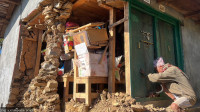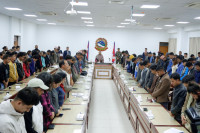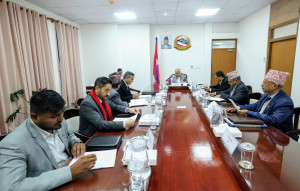Columns
A peak of many names
Baburam Acharya’s claim that Sagarmatha is the native name of Everest is perhaps not quite true.
Deepak Thapa
I continue where I left off a couple of weeks back, retracing some of the history of the naming of Everest. I began my last article with our Prime Minister, KP Sharma Oli, declaring matter-of-factly and with the full weight of his office that the one and only monicker for the highest peak in the world is Sagarmatha and also that since it is a name, it cannot be translated. Of course, within a few weeks Oli’s self-assuredness was found conspicuously missing when, during the ‘Sagarmatha Sambaad’, the Chinese dignitary Xiao Jie continually referred to the mountain as Qomolangma. Even though Oli’s own speech followed Xiao’s, nary a word of protest did he utter against the Chinese official’s disregard of the host’s fond wish regarding the use of ‘Sagarmatha’.
Oli may not be aware, but as someone schooled in communism, he would certainly be sympathetic to the fact that as a loyal member of the Communist Party of China (CCP), it would have been anathema for Xiao to refer to the mountain by anything other than Qomolangma. As Time magazine reported back in June 1952: ‘Last week, Red Peking [as the West sometimes disparagingly used to call the communist regime], which recently gobbled up Tibet, decreed that Everest (which no one has ever climbed to the summit) will hereafter be known by its ancient name, Chomolungma.’ (Qomolangma, by the way, is just the Chinese rendering of Chomolungma, with the pronunciation being more or less the same, allowing for differences in accents.)
Thankfully, Oli has not issued a similar decree. And, even if he were to, we would be at full liberty to ignore it unlike the foot soldiers of the CCP.
Whence came Sagarmatha
But, what of Sagarmatha, and whence its provenance? It is quite well known that the name came from a 1938 article by historian Baburam Acharya in the literary magazine, Sharada. Although the original or its reprint in a school textbook sometime later are both difficult to access, Himalkhabar.com helpfully posted the full text of the original a few years ago.
Entitled ‘Sagarmatha or Jhyamolongma’, and written in the syntax of the time, Acharya’s article makes for difficult reading. Plodding through it though is instructive—not only in understanding how and why he came up with ‘Sagarmatha’ but also the brief glimpse it provides into how the educated class in Kathmandu viewed outlying parts of Nepal and the people living there. Missing from the essay’s title is ‘or Everest’, which is understandable since the whole point of the article appears to have been to establish the fact that the mountain already had a local name. Acharya declares at the very outset: ‘The highest peak in the Mahalangur range is known as Sagarmatha in Nepal and “Jhyamo-longma” in Tibet.’
For starters, Acharya seems to have mis-heard the Tibetan name. Anyone who has heard native Tibetan-speakers will know that when enunciated, ‘Chomolungma’ sounds very much like ‘Jhyamolongma’. Thus, he unnecessarily expends part of his article explaining the origins of a word that does not exist.
It is tough following the drift of his argument. But, in brief, Acharya touches on the history of Khas-Arya migration to Kirat lands in eastern Nepal and asserts that the newcomers began giving names to the various landforms they encountered in their new home. Acharya argues that extant Kirat names were either ‘pleasing to the ear’ or ‘not pleasing to the ear’. In the case of the latter, the new migrants ignored what existed and gave new appellations even as they retained those that sounded pleasant. One example he provides of a ‘sweet-sounding’ name is ‘Kosi’. In support of his argument, Acharya writes that the Kirats used ‘Kosi’ as a prefix before the names of rivers, and the same was adopted by the ‘newly arrived Bahun-Chhetri in Sun-Koshi, Tama-Koshi, Dudh-Koshi, etc’. By that same token, he says, the two great ranges around Everest lost their ‘harsh-sounding’ Kirat names and were instead called Mahalangur and Kumbhakarna in the Parbate language (i.e., Nepali) while the peak became known as Sagarmatha.
Acharya translates ‘Sagarmatha’ as the ‘Head that Reaches into the Sky’ and belabours the point that the mountain’s loftiness justifies the name. He even goes to claim that while people from Kathmandu have no clue what Sagarmatha is, for the people from the Kirat region who live in sight of the peak the name is known to them as a matter of course.
I find the last part quite hard to believe for unless you can go to very high elevations, Everest remains generally hidden from all sides facing south. And when visible, it does not betray its height, certainly not from the midhills. Only when one is in Syangboche above Namche Bazaar does one begin to appreciate its majesty, peering out from above the equally formidable Nuptse.
Kamal Prakash Malla is much more brutal in his criticism. In an article titled ‘Sagaramatha: The Linguistic Conquest of Mount Everest’, the linguist in Malla is indignant. He calls Acharya’s distinction between names that sound ‘sweet’ and ‘harsh’ a ‘questionable theory’ and ‘simplistic’. He notes that nearly three decades later, Acharya himself wrote that the reason for his earlier article was because ‘he was deeply aggrieved not to see a Nepali name for the world’s highest peak located in Nepal’. Which is entirely possible and also does not exclude the possibility that ‘Sagarmatha’ was indeed part of common parlance in Kirat country.
Except that Acharya appears to have come across the name not through careful research. Malla continues: ‘When I casually met him in person in the Royal Press Secretary’s Office on Friday July 14, 1967, I asked him about the source of his information: where or how he got the word. From the brief conversation, it became painfully clear to me that he picked up the name from a third-hand source—through his local staff in the Education Department [where Acharya was employed at the time of the Sharada article]!’
It was on the basis of one somewhat dubious informant that Acharya went on to claim that Sagarmatha was the native name for the highest mountain in the world. As Malla writes further: ‘To add to this confusion, Acharya himself, in an interview [in the early 1960s]…said that Sagaramatha is actually translated as “Heaven Peak” by the Europeans and that Chomolungma, too, is a translation of the Nepali name Sagaramatha.’
Malla provides an array of possible origins for ‘Sagarmatha’ but is unsparing towards Acharya’s thesis. He writes: ‘[T]here is every reason to doubt the authenticity of the etymology as well as the form of the compound as proposed by Baburam Aacharya and uncritically recognized and popularized during the Panchayat regime by the State machinery in Nepal.’
Chomolungma in Sagarmatha
I will end with this extract from Walt Winsworth’s Everest. ‘In October 1975 I was walking through the Sagarmatha National Park with a Sherpa guide and a porter. The porter was a simple, illiterate peasant, the guide one of the modern breed well educated in the school in Khumjung. When Everest came into view I turned to the guide and said, “Ask Lakpa what he calls that mountain,” which he did.
‘“Chomolungma,” said Lakpa, without hesitation.’




 19.12°C Kathmandu
19.12°C Kathmandu















